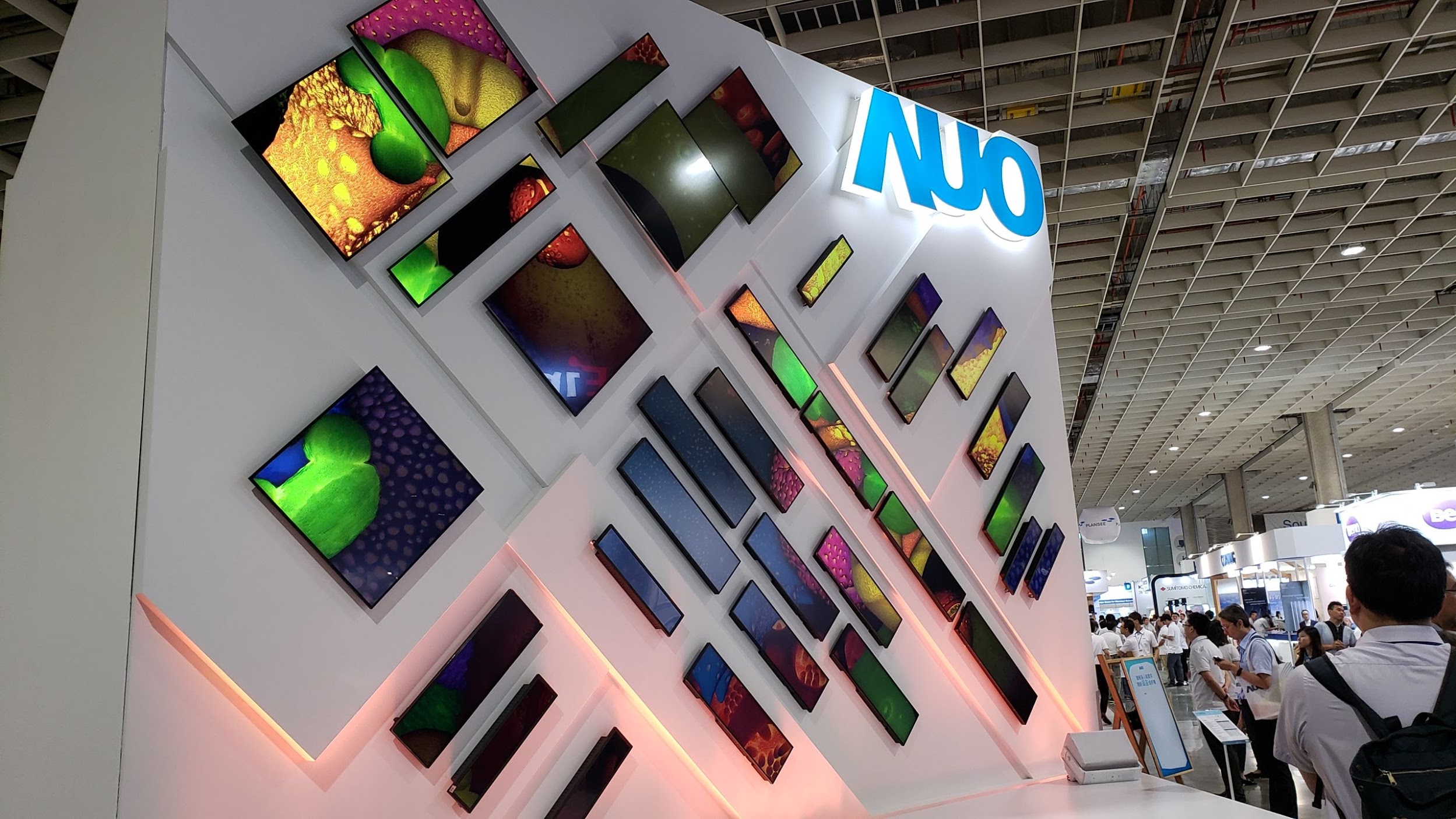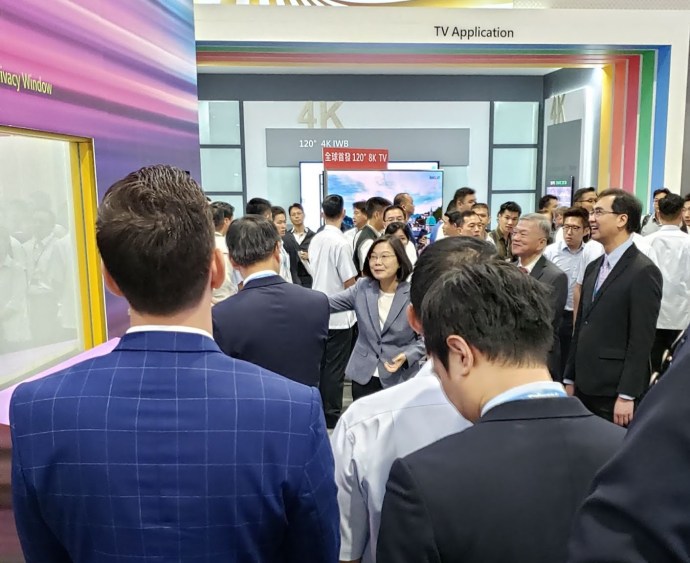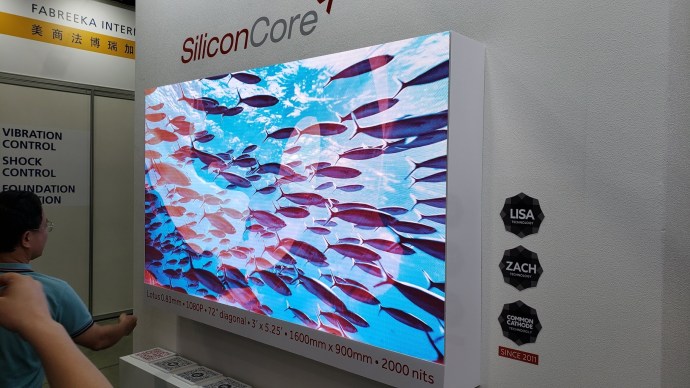
Day One Impressions From Touch Taiwan – Mini And Micro LED On Rise
August 28, 2019 by Dave Haynes
Well this was going to be a pain in the butt, I thought, as I went through airport-level security screening to get into the exhibit hall Wednesday for the first day of Touch Taiwan. There were scanners and bag checkers and line-ups.
Then I realized Tsai Ing-wen, Taiwan’s president, was at the opening of the event, handing out digital signage awards and walking booths. The display industry and its ecosystem is big business in this country, and fertile ground for shaking hands and showing interest.

Once she was gone, so were scores of photographers, and the security scanners.
I am at this trade show in Taipei at the invitation of some industry trade associations who want to get the word out beyond this region that the show exists and that there is a lot shaking on this island. They flew me here, put me up, and yesterday had a media lunch that had, I think, 1,257 courses. It just … kept … coming.
Mercifully, there were no toasts involving drinks. I’ve been to group dinners that start innocently enough, and then people are asked to stand and say a few words and toast the others, and then fire back your drink. That can get fun and sloppy.
While mainland China and South Korea would seem the obvious hubs of innovation and manufacturing for consumer and commercial display electronics, Taiwan is a disproportionately large player, as well. They also make a lot of panels that other brand names use.
The show is held at a very large, very modern convention hall that is well out from the central business district, but very close to a semi-suburban office park that is almost all tech and banking. IAdea, for example, is a few blocks away. Some of the big manufacturers, like AUO and Epistar, have plants about 60-90 minutes south. I am heading that way for an AUO plant visit later today.
This would be a good show to walk for offshore visitors if they are looking for manufacturing partners or emerging tech that aids in manufacturing of display tech. The big flat panel manufacturers like AUO and Innolux (which has roots in another display firm, Chi Mei) had giant booths at the back, as well as Eink and Corning.
Unlike pretty much every AV show I have been to in the last few years, this show is not riddled with giant direct view LED screens. Taiwan does LED die (like Epistar) and packaging (like Sander), but otherwise that is happening mostly in China (though Silicon Core has much of its business here).
One thing I found interesting was the main AUO visual, which was a mosaic of stretched and square displays. Odd formats like that popped up years ago, notably from LG, but were costly and unreliable because they were larger displays that had been cut and effectively re-manufactured. These are native sizes and in volume, AUO can do custom sizes.

There are lots of familiar (to me) companies like Silicon Core, showing super-premium fine pitch LED, like a 0.83 with a hardened surface.
And there are many companies that make flexible glass and have machines that are various stages of the LCD and LED display process, from growing LED die on wafers to moving finished displays on production lines using addressable airbed jets instead of conveyor belts.
Cool stuff.
I was most interested, naturally, in what’s happening on the display, particularly as it relates to mini and micro LED. First, I am trying to figure the two out (purists have their definitions, but some brands ignore that and call their stuff what they want).
I saw direct view mini LED, definitely, and some microLED. The micro stuff is really interesting because from what I could get in my chats with technical people (who spoke English, I have zero Mandarin), the die are so small you really do need a microscope to see them.
The more easily understood story for me was how these technologies are starting to supplant more conventional packaged LEDs for the backlighting of commercial and premium consumer displays. That tech replaced the skinny fluorescent light tubes that were the original light source for LCD with brighter, lighter and skinnier light boards.
Now miniLED is allowing things like a 65 inch 8K display with 9,600 backlights that are all locally controlled – meaning the tech is there to shut off the light down to the pixel. When you can do that, you get real blacks and the same visual impact as an OLED, which is also controlling light down to the pixel.
Both Innolux and AUO had jaw-droppers. Some of the really amazing work was on premium gaming displays (a big consumer market), with that local light dimming but also very high refresh rates.
A little curiously, there is not that much touch technology at Touch Taiwan. I should have asked if that is how it started and then things evolved. Or the touch part has a different meaning – like touch base with the sector.
Looking at time and thinking I need to get my act in gear – clean up, eat and roll. Going to some seminars today on mini and micro LED. In lieu of more impressions, here’s a pile of tweets from day 1 for those who don’t bother with that platform and therefore wouldn’t have seen them. If you did, move on ;-]



Leave a comment